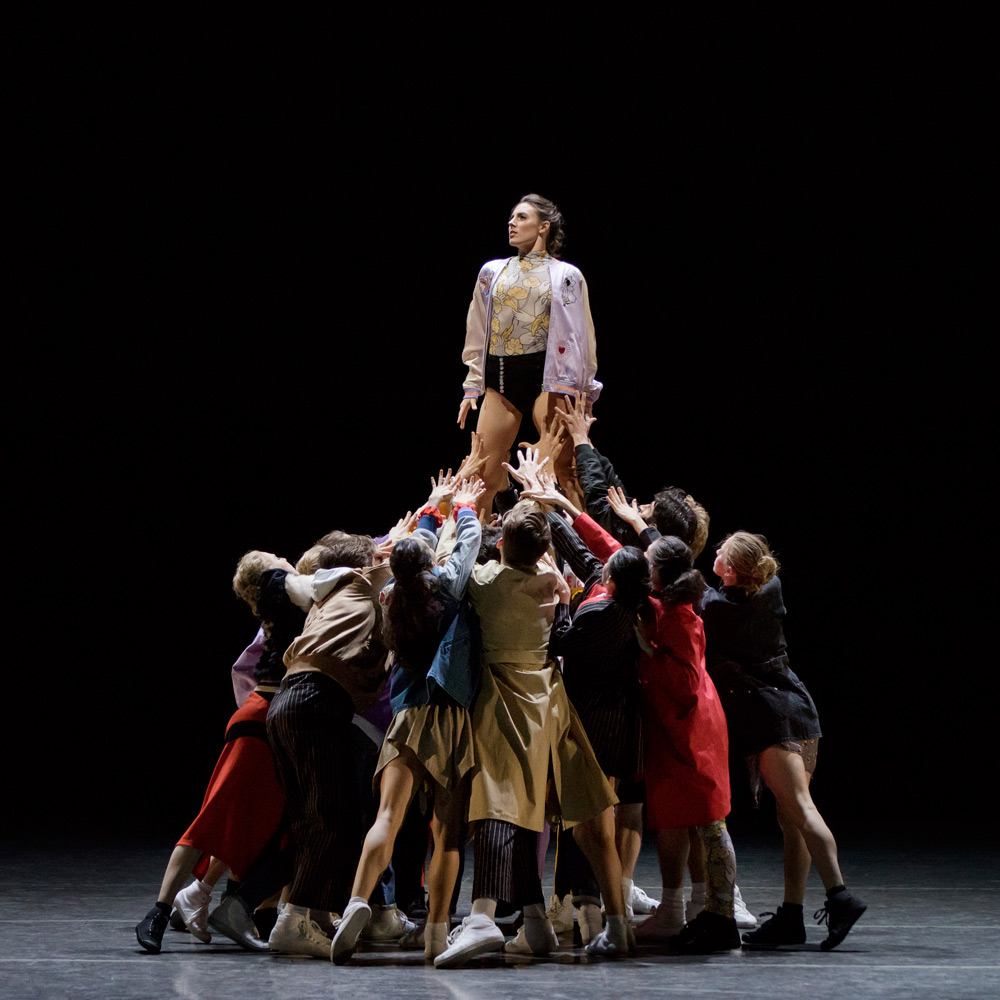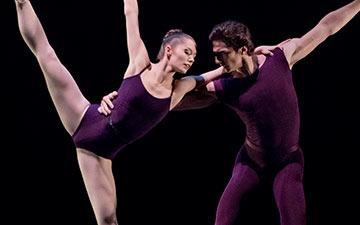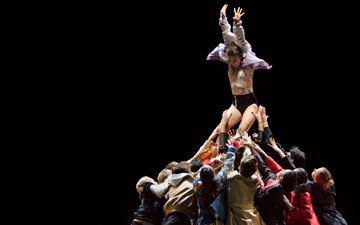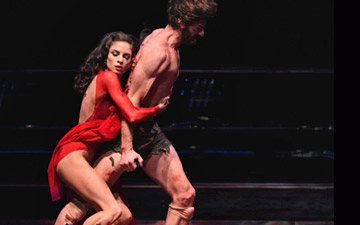
© Paul Kolnik. (Click image for larger version)
New York City Ballet
New Combinations: Fearful Symmetries, The Shimmering Asphalt, The Times are Racing
★★★✰✰
New York, David H. Koch Theater
26 January 2017
www.nycballet.com
davidhkochtheater.com
In the Age of Anxiety
How does art react to events in the larger world? Kurt Jooss made his dance about a looming world war, The Green Table, in 1932. Paul Taylor protested the Iraq War in Banquet of Vultures, in 2006. More recently, we’ve seen Kyle Abraham make a dance about the mass incarceration of black men, for Alvin Ailey (Untitled America). Mainstream ballet is less inclined toward political statements, but in a recent interview Justin Peck, the resident choreographer at New York City Ballet, made the point that his new work, a ballet set to electronic music and danced in sneakers, was in part a response to the election of Donald Trump.
But it’s a delicate balance, making political art, and, if this was Peck’s intention, The Times are Racing falls somewhat short. Perhaps, though, this standard is unfair. The dance does project a strong feeling of – what is it – anxiety, raw energy, solidarity. The music, by Dan Deacon, is loud, raucous, and a little deadening. This may help to explain the general lack of affect – or is that more a reflection of the millennial attitude? The costumes, by Humberto Leon, are drawn from everyday street fashion, raggedy and colorful: hoodies, shorts, unevenly cut skirts, jeans. Some of the shirts are emblazoned with words – Unite, React, Shout, Defy – though they are not easy to make out from the audience. The movement is explosive, a little aggressive, with slicing arms, kicking legs, falling bodies, hips pushed forward provocatively.
More than anything, the dance reminded me of the movie Rebel Without a Cause. These kids are uneasy, but what is the object of their unease? Partially, this ambivalence comes from the fact that the dancers are represented as kids, not fully-grown adults. As in Jerome Robbins’ N.Y. Export: Opus Jazz (an inspiration, perhaps) the dancers are young, but not quite as young as the characters they portray. The energy is adolescent, frazzled. “What is going on?” they seem to be saying. But the preoccupations remain personal, not universal – what is my place in the group? How do we relate to one another? Tiler Peck and Amar Ramasar engage in an extended pas de deux in which she teases him with her exposed hips – she’s wearing really short shorts – moving them with casual, grounded sexiness, in the vein of Twyla Tharp. The two face off, compete, but never quite connect. Eventually they support each other in a series of hip-hop like one-handed flips in which their legs cross in the air. Perhaps competition is the only real form of connection in this world.

© Paul Kolnik. (Click image for larger version)
The most significant dynamic is that between Robert Fairchild and Justin Peck, who for the first time has cast himself in one of his ballets. The two have known each other since they were roommates at the School of American Ballet, and their casual intimacy provides an anchor for the whole piece. In one of the sections, set to the track “Rail” from Deacon’s album America, the two men careen across the stage in a Fred-Astaire-esque passage of soft-shoe, arms open, bodies gliding. You can’t hear the feet because of the loud, rhythmic music. Is this the first time NYCB has used recorded music for a ballet? But the dancing is less debonair than driven, competitive, athletic and hard-driving, like the dance-off between Baryshnikov and Gregory Hines in the movie White Nights. Even desperate, I would say. The stark lighting, by Brandon Stirling Baker, adds to the sensation of panic. Fun propelled by anxiety.
Peck, a great mover of ensembles, once again shows his chops in this department. Recently he has been exploring the deployment of clumps of bodies from which emerge individual dancers, a theme that frames this ballet. Chains and right angles form and then dissolve to re-emerge again elsewhere. In a later section, the dancers join arms in what looks like a giant strand of DNA, undulating, and then breaking apart, molecules flying. It’s a cool effect, even dazzling, but feels almost too neat, blunting the energy of this manic work. There is sincerity and freedom in The Times Are Racing, but at times it comes dangerously close to looking like a music video.

© Paul Kolnik. (Click image for larger version)
That said, The Times Are Racing has a great deal more impact than the other new work unveiled on January 26, Pontus Lidberg’s The Shimmering Asphalt. This is Lidberg’s first ballet for the company. Lidberg is a choreographer with a poetic disposition, by which I mean that his dances tend toward moody adagios in which the dancers partner each other sensitively, with legato phrasing, and look out searchingly at the audience. Here, ten principal dancers – all presented as glorious statues through the use of overhead lighting by Mark Stanley – form morphing shapes across the stage, hooking, sliding, gliding in continuous waves. The music, a commissioned score from David Lang, is pensive, at times soaring or pointillist, toward the end more emphatic. But like the dance, it doesn’t develop, leaving the dancers to move through an even-toned landscape of sound.
The look, too, is even-toned: gray pleated skirts and tops – or no tops – evoking peplums or ballet tunics (by Rachel Quarmby-Spadaccini). The men, too, are in skirts; some of them too short and rigid, almost like tutus. The effect of all this neutrality is that it makes the dancers seem almost interchangeable, dulling any tension between them. And this, despite the fact, that the cast includes Sterling Hyltin, Lauren Lovette, Russell Janzen, and Taylor Stanley – all wonderfully individual dancers. The only dancer who manages to stand out is Sara Mearns, who, at various points, walks on, with exquisite slowness, facing the audience, moving as if lost in her own thoughts. Later, she joins a quartet of men, only to be lifted up by them, arms extended to the sides, like a totem. Mearns has mastered the art of stage presence; seemingly without trying she holds the audience in her thrall, drawing it into her inner world.
The evening opened with Peter Martins’ 1990 work Fearful Symmetries, with a fantastic cast of mostly young dancers. Standouts include Claire Kretzschmar, Russell Janzen, Harrison Ball, Spartak Hoxha and the young corps-member Alston MacGill. It’s an adrenaline-driven work, set to John Adams’ eponymous work for winds, brass, and synthesizers. A blast of movement, in which dancers seem to fly and whirl from one wing to the other in surging waves of energy. Legs are flung forward, leaps erupt from running steps; men toss women into the air, almost always from behind. The look is stylish, urbane, flat. It’s a little bit like Jerome Robbins’ Glass Pieces, on steroids. A ballet for a brassier, more confident time.

















You must be logged in to post a comment.